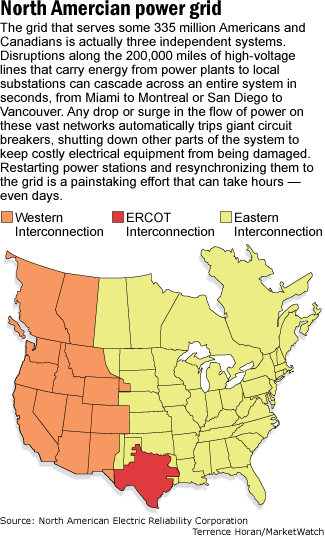 The urgent need to upgrade the gridJul 11, 2008 - Jim Jelter - MarketWatch.com SAN FRANCISCO (MarketWatch) -- Flip on the lights, zap the coffee, check the charge on the cell phone -- all part of an increasingly energized morning routine in millions of homes. Electricity demand is growing at about 1% a year, according to the U.S. Energy Department, and is likely to hold that pace despite a sluggish economy. That's because of demographic growth -- more people -- and the explosion in the numbers and types of electronic devices now considered essential. Meeting that demand focuses inevitably on power generation. But power is useless without the vast transmission networks that carry it to end-users. Those networks draw on 100-year-old technology and high-voltage lines, most of which were installed in the 1950s and '60s It is a fragile system struggling to keep pace with the times. When it fails, as it did spectacularly in the Northeast in 2003, it costs businesses millions of dollars in lost goods and productivity. It also raises huge safety concerns. During the go-go years of deregulation a decade ago, huge amounts of money were thrown at building power plants while investments in the grid lagged. Overloaded lines and serious reliability problems were the result. Those weaknesses are now being addressed. The Edison Electric Institute reported transmission investments by publicly-traded utilities jumped last year to $7.8 billion from $2 billion in 1997. Over 240 miles of much-needed high-voltage lines have been added in the Western states alone in just the past year. That doesn't mean the grid is anywhere close to where it needs to be, however. Power transmission into Southern California remains a concern, for example, since the region still relies heavily on energy generated at plants as far away as Washington and Wyoming.
Cost is another concern. Soaring fuel prices at coal and natural gas-fired power plants are pushing electricity prices sharply higher. This is a huge catalyst in the development of "smarter" power grids that give regional operators a quicker, clearer view of conditions on the system and the ability to remotely reach out to better manage the flow of power. But the system also faces financial challenges that are every bit as tough to solve as the technological challenges. Maintenance of the transmission system is still primarily the responsibility of regional power companies. Operational standards, set for years by the North American Electric Reliability Corporation, first became mandatory and enforceable a year ago. But it's still in the utilities' own interest to make sure everything is up and running. They can't make money if the lines are down. But the cost of upgrading the transmission system is high. Ultimately the cost is borne by ratepayers -- the industry's term for the businesses and homeowners who pay the bills. State utility commissions and the Federal Energy Regulatory Commission, which oversees interstate power and gas commerce, are often reluctant to raise rates -- a guaranteed political hot potato -- which slows the flow of funding to transmission projects. Streamlining the regulatory process is therefore essential to ensuring utilities a reasonable rate of recovery on their investments while assuring the public they are not being preyed upon by unbridled monopolies. Privatization could be one way around the stalemate. There have been several proposals aimed at putting transmission lines in private hands. Some states have already "unbundled" the grid, allowing companies to own and operate transmission lines much like transport companies with no stake in power generation or sales to end-users. But privatization still doesn't solve thorny regulatory issues. It merely adds another layer. Meanwhile, some of the most innovative thinking on transmission grids is coming from entrepreneurs well outside the traditional utility industry. Efforts to reduce the nation's carbon footprint and meet growing energy demand have turned this into one of the hottest fields for venture capitalists, attracting billions of dollars. Expectations are high that their combined efforts will spawn the next generation of grid upgrades. Fitting all the pieces together, the technology, capital and regulatory regime, is a daunting task. Progress is clearly being made. Much more is needed. Failure to keep pace with domestic requirements would leave the country in the lurch, with an economy leaning on a creaky electrical infrastructure. Excelling at the task would give the country a much-needed competitive boost in the global arena. End of Story Jim Jelter is Industrials Editor for MarketWatch in San Francisco. |
Email this page to a friend
If you speak another language fluently and you liked this page, make
a contribution by translating
it! For additional translations check out FreeTranslation.com
(Voor vertaling van Engels tot Nederlands)
(For oversettelse fra Engelsk til Norsk)
(Для дополнительных
переводов проверяют
FreeTranslation.com )


